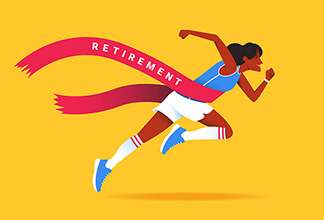This Budgeting Trick Can Help With Your Financial Goals
Written by Sarah Newcomb, Morningstar
Published on February 17, 2023
minute read
Share:
This Morningstar‡ report was first published on 18 January, 2023
How do you know if you’re saving enough? How much debt is too much? What’s a healthy consumption rate?
I recently spoke with a woman in her early 20s who has moved out of her parent’s house and is trying to figure out how to steer her financial ship now that she’s the only one behind the wheel. She is off to a great start, but she’s wondering how to prioritize spending and saving now that she’s in a new stage of her financial life.
What’s realistic to spend on restaurants or transportation? How much “should” a person in their 20s be saving?
For her and people in a similar position, I’m going to provide a budgeting tool that skips all the scrutinizing and itemizing and gets right to the heart of what you need to know: Is your cash management healthy? Are you saving enough?
The answer to these questions as a specific dollar amount isn’t helpful because everyone’s finances are different. Instead, I’d like to introduce you to the Golden Ratio for personal finance.
Determine your golden ratio
What’s a Golden Ratio? It’s a formula you can use to figure out how you spend your income. Your Golden Ratio is made up of three numbers, representing the percentage of your gross income that goes to:
-
The Past—Paying for things you bought/did in the past
-
The Present—Funding your current lifestyle
-
The Future—Accumulating to create future income
Someone earning $60,000 per year who saves $500/month (the future) and has debt payments of $500/month (the past) would have a Golden Ratio of 10 | 80 | 10. Ten percent of every dollar they earn goes toward debt, 80% is consumed in the present through taxes, groceries, rent, and everything else, and 10% is saved for the future.
Past: your debt/income
To calculate the past portion of your Golden Ratio (also known as the Debt/Income Ratio), add up all of your monthly debt payments (principal and interest). Then divide this by your gross monthly income and multiply by 100. For example, if you earn $6,000/month before taxes and pay $2,000/month toward your mortgage, credit cards, car loan, and student loans, then the past portion of your Golden Ratio would be 2,000/6,000 * 100 = 33.3, meaning that 33% of your income is directed toward paying off past purchases.
Many people want to exclude the principal on mortgages from this calculation, reasoning that this expense is more appropriately assigned to the “present” because it’s a current housing expense. I disagree for two reasons. First, you borrowed the full amount, and the principal you pay is a contractual debt obligation, not a monthly rent payment. Second, creditors include the entire mortgage payment (principal and interest) when considering your creditworthiness, so you should use the same debt/income ratio as they do.
How much debt is too much?
Some debt is manageable. Overwhelming debt can be a poverty trap. Borrowing to invest in income-generating assets like real estate and career skills can put you in a better financial position in the long term. Home and school loans are considered “good debt” by creditors and don’t hurt your credit score nearly as much as other types of debt.
Borrowing to buy transient or intangible things (think: vacations, fine dining, cars, boats, TVs) usually weakens your financial position in the long run because you pay interest on things that you can’t resell at retail, let alone with interest. You’re effectively poorer at the end of the transaction than you were at the beginning. Therefore, consumer debt is treated as “bad debt” by creditors and drags your credit score down more than “good debt” does.
Regardless of the quality of your debt, you should aim to keep your total debt payments at or below 30% of your gross income. The ratio of your monthly debt payments/monthly gross income is also known as your debt/income ratio and is used by lenders and credit bureaus to determine your creditworthiness. As a rule, you want to keep your total debt obligations at or below 30% of your monthly pretax income.
However, if you find yourself overwhelmed by debt or if you simply want to pay off some or all your debt as quickly as possible, then by all means put more than 30% toward the past. It is only when your required debt payments reach 30% that you need to be concerned.
Bottom line: Keep the past portion of your Golden Ratio below 30.
Future: your savings rate
The next calculation jumps to the future. To calculate the future portion of your Golden Ratio, add up all of your monthly savings contributions, divide this by your gross monthly income, and multiply by 100. Building on the previous example, if you earn $6,000/month before taxes and save $1,000/month, then the future portion of your Golden Ratio would be 1,000/6,000 * 100 = 16.7, meaning that 16.7% of your income goes toward your future.
How much you should save depends on your goal and your time horizon (the number of years between today and your goal). You need to have at least a rough idea of both in order to know if you are saving anything close to “enough.”
There are many different views on how much a person needs to save to fund a secure retirement. Fidelity recommends having 10 times your desired retirement income saved in order to stop working at age 67. We’ll call this goal a 10X income multiple. In the case of someone earning $60,000/year, they would need $600,000 to retire at age 67, using this rule of thumb. Someone who wants a $100,000/year lifestyle would need $1 million, and so on.
Some of us are aiming a bit higher. We want to save enough assets to live off the interest and not need to touch the principal. If you are aiming for this, then (based on the 4% rule, which is itself a subject of hot debate) your goal would be a 25X income multiple or higher.
I personally advise people to save at least 20% of their gross income. If that’s not possible, then start with what you can save and work your way up. Saving anything is better than nothing, but a consistent 20% savings rate over time is, in my opinion, a sound rule of thumb.
Present: your consumption rate
This takes us back to the present. This portion of your Golden Ratio is 100 - (Past + Future). Using our previous example, if you earn $6,000/month, save $1,000/month, and pay $2,000/month in debt, then your Present = 100 - (33.3 + 16.7) = 50, meaning that 50% of your income is consumed by your present lifestyle. You can think of this as your consumption rate or burn rate. Taxes, groceries, rent, gifts, and so on … if you didn’t save it, it is considered to be consumed. Period.
Adding it up and setting goals
Let’s run through an example from beginning to end. For simplicity, imagine a person who earns $120,000 per year ($10,000 per month). Their monthly debt payments add up to $3,500, and they save a total of $1,500 per month.
1) Past = 3,500/10,000 * 100 = 35
2) Future = 1,500/10,000 * 100 = 15
3) Present = 100 - (35 + 15) = 50
Their Golden Ratio would then be: 35 | 50 | 15 (in Past | Present | Future order). If this person is trying to grow their assets, they will need to make some changes. They can use these numbers to set goals for a healthier cash flow.
First, their past is greater than 30, so they could set a goal to reduce this to 30 as quickly as possible. Second, their savings rate could be larger. Let’s assume they set a goal to have a Golden Ratio of 30 | 50 | 20 within two years. They can do this by refinancing high-interest debt and paying off debt and then putting the money saved on interest toward their savings.
How the golden ratio makes budgeting easy
If your debt is healthy and you have achieved your savings goal, then you can spend the rest guilt-free! It doesn’t matter if you spend it on restaurants or vacations or clothes or model trains. If your past and future are in good shape, then you can skip all the itemizing and agonizing and just enjoy your life and your money.
This is where the Golden Ratio is really powerful, in my opinion. It distills your cash flow into one very informative metric so you can know instantly if you are on or off track. If you are on track, spend with impunity! If you are off track, you’ll know where to focus. If debt is the issue, look at refinancing high-interest-rate accounts and making a budget that is both satisfying and sustainable. If saving is the issue, the same strategies can help you find dollars to devote to your future.
RBC Direct Investing Inc. and Royal Bank of Canada are separate corporate entities which are affiliated. RBC Direct Investing Inc. is a wholly owned subsidiary of Royal Bank of Canada and is a Member of the Investment Industry Regulatory Organization of Canada and the Canadian Investor Protection Fund. Royal Bank of Canada and certain of its issuers are related to RBC Direct Investing Inc. RBC Direct Investing Inc. does not provide investment advice or recommendations regarding the purchase or sale of any securities. Investors are responsible for their own investment decisions. RBC Direct Investing is a business name used by RBC Direct Investing Inc. ® / ™ Trademark(s) of Royal Bank of Canada. RBC and Royal Bank are registered trademarks of Royal Bank of Canada. Used under licence.
© Royal Bank of Canada 2023.
‡ All other trademarks are the property of their respective owner(s).
Any information, opinions or views provided in this document, including hyperlinks to the RBC Direct Investing Inc. website or the websites of its affiliates or third parties, are for your general information only, and are not intended to provide legal, investment, financial, accounting, tax or other professional advice. While information presented is believed to be factual and current, its accuracy is not guaranteed and it should not be regarded as a complete analysis of the subjects discussed. All expressions of opinion reflect the judgment of the author(s) as of the date of publication and are subject to change. No endorsement of any third parties or their advice, opinions, information, products or services is expressly given or implied by RBC Direct Investing Inc. or its affiliates. You should consult with your advisor before taking any action based upon the information contained in this document.
Furthermore, the products, services and securities referred to in this publication are only available in Canada and other jurisdictions where they may be legally offered for sale. If you are not currently a resident of Canada, you should not access the information available on the RBC Direct Investing Inc. website.
Explore More

Should I Invest or Pay Down My Mortgage?
Consider these four questions
minute read

As Many Head Back to the Office, Where Could Investors See Changes?
How returning to in-person work could affect a range of investments
minute read

Considering the FIRE Lifestyle? Here’s What Your Investments Might Look Like
We asked three people how they created financial independence and retired early
minute read
Inspired Investor brings you personal stories, timely information and expert insights to empower your investment decisions. Visit About Us to find out more.







